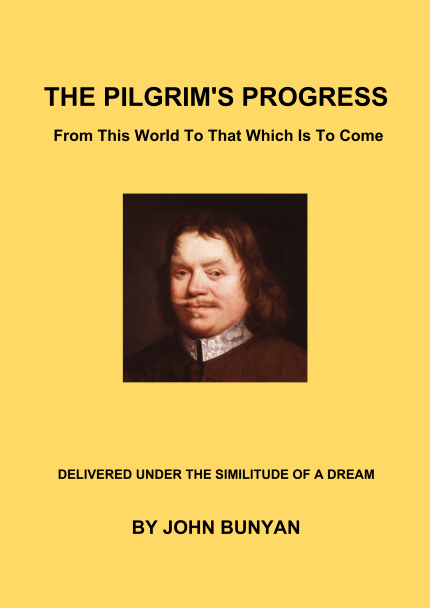
The Pilgrim’s Progress from This World, to That Which Is to Come
Delivered under the similitude of a dream.
By JOHN BUNYAN
General Overview:
The Pilgrim’s Progress, a Christian allegory, is considered a significant work of religious fiction in English literature. Released in 1677, it has been translated into over 200 languages and has never been out of print. Written by John Bunyan, it is regarded as the first novel in English.
Christian’s Journey:
The Pilgrim’s Progress follows the journey of Christian from the City of Destruction to the Celestial City, symbolizing heaven. This allegory portrays a Christian’s spiritual life through everyday characters and their experiences, reflecting biblical teachings.
Characters and Symbolism:
In his journey, Christian encounters characters like Evangelist, Ignorance, Worldwise, and Money-Love, each representing facets of a Christian’s spiritual experiences. The story unfolds with Christian’s realization of sin, his encounter with the cross, and interactions with companions like Hope and Faithful.
City of Vanity and Trials:
At the fair of the City of Vanity, Christian’s companion, Faithful, is arrested and executed. The narrative delves into encounters with characters like Giant Despair, depicting trials on the Christian journey. Ultimately, it explores the theme of overcoming challenges in the pursuit of eternal glory.
About John Bunyan:
Learn about John Bunyan (1628-1688), the author of The Pilgrim’s Progress. Born in Elstow, England, Bunyan’s early life, military service, and conversion to Christianity influenced his later work. His imprisonment for preaching without a license led to the creation of his most famous book.
Imprisonment and Writing:
John Bunyan’s imprisonment in 1660 for preaching without permission became a turning point. During his 12.5 years in jail, he wrote The Pilgrim’s Progress, which sold over 100,000 copies in its first decade. His life, marked by challenges and faith, is a testament to the enduring power of his work.
The Pilgrim’s Progress and Bunyan’s later life and end.
Released in 1677, Bunyan spent the last ten years of his life ministering to his congregation and writing. In August 1688, as he was riding from Reading to London, Bunyan caught a cold and developed a fever. He died at the house of his friend John Strudwick
It is an allegory
This book talks about a journey executed by its main character, Christian from the City of Destruction to Celestial City which stands for heaven. The Pilgrim’s Progress represents a Christian Journey into Eternity. The facets of a Christian’s spiritual life are portrayed by persons of everyday life, portrayed as travelers. The personal names of these travelers represent a certain characteristic. Christians spiritual experiences can be found back in the Bible (see added Bible verses) and are the experiences found back in the journey of christians of all ages.
Christian lives with his wife and children in the City of Destruction.. He finds out by reading a book (the Bible) that he is a sinful man and must flee from the wrath to come. Christian goes on a journey with a burden on his back, symbolising sin.
Christian travels through the narrow gate and is delivered from his burden suit (sin) at the cross. He meets many people with names such as Evangelist, Ignorance, Worldwise,, Atheist and Money-Love. Two of Christen’s companions are Hope and Faithful. At the fair of the city of Vanity, Faithful is arrested and put to death.
Christen and Hope travel on and are later captured by Giant Despair. After the escape, they come before Deathsjordaan, which depicts the death of a Christian. After crossing this, Christen and Hope are taken up in the Eternal Glory of Celestial City.
About John Bunyan (1628-1688)
Bunyan’s youth
John Bunyan was born at Elstow, near Bedford, England, the oldest son of Thomas and Margaret Bunyan. Bunyan’s father was a brazier or tinker who travelled around the area mending pots and pans, and his grandfather had been a chapman or small trader. As a child Bunyan learned his father’s trade of tinker and was given some schooling but it is not known which school he attended.
In the summer of 1644 Bunyan lost both his mother and his sister Margaret. That autumn, shortly before or after his sixteenth birthday, Bunyan enlisted in the Parliamentary army. Discharged from the army after three years, Bunyan married a God fearing woman in 1648, who brought two books to the marriage: The Plain Man’s Pathway to Heaven by Arthur Dent and The Practice of Pietry by Lewis Bayly.
These convicted Bunyan of his sin and he made attempts to reform his life. But he realised that he was lost and without Christ when he came into contact with a group of women whose ‘joyous conversation about the new birth and Christ deeply impressed him’. The women intoduced him to their pastor, John Gifford, who was instrumental in leading Bunyan to repentance and faith.
Imprisonment
In the following years, Bunyan began publishing books and became established as a reputable Puritan writer, but around this time, his first wife died. He remarried in 1659, a godly young woman named Elizabeth, who was to be a staunch advocate for her husband during his imprisonments. For in 1660 Bunyan was arrested for preaching without official permission from King Charles the second; he was in jail the next 12,5 years.
He was eventually released in 1672, and took up his pastorate in Bedford. After some fruitful years of ministry, in March of 1675 Bunyan was again imprisioned for preaching publicly without a license. It was during this time that he began to write his most famous book.
Looking for a Hardcover or Paperback?
For those who want to have a hardcover or a paperback of this book. I want to suggest you to look here.